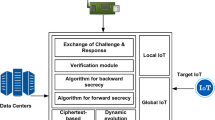Abstract
Internet of Things (IoT) is one of several technology trends, and IoT applications are found in a wide range of industry sectors such as healthcare and critical infrastructure. Authenticated key exchange schemes play an important role in protecting user and data privacy and ensuring the security of data-in-transit in IoT infrastructure (e.g. via user identification and provision of secure communication). However, designing secure authenticated key exchange (AKE) schemes remain a challenging task. In this paper, we reveal that Challa et al.’s three-factor AKE scheme is vulnerable to a number of known attacks. Then, we present an improved signature-based three-factor authenticated key exchange protocol and prove its security under the extended model of Bellare et al. (Tecnologia Electronica E Informatica 1807:139–155, 2000). A comparative summary is also presented, which demonstrates that our proposed scheme is sufficiently lightweight for IoT deployment and outperforms those of Challa et al. (IEEE Access 5:3028–3043, 2017) and Turkanovi et al. (Ad Hoc Netw 20(2):96–112, 2014), in terms of security features, computation and communication costs.



Similar content being viewed by others
References
Abdalla M, Fouque PA, Pointcheval D (2005) Password-based authenticated key exchange in the three-party setting. In: International conference on theory and practice in public key cryptography, pp 65–84
Amin R, Islam SH, Biswas GP, Khan MK, Leng L, Kumar N (2016) Design of an anonymity-preserving three-factor authenticated key exchange protocol for wireless sensor networks. Comput Netw 101: 42–62
Atzori L, Iera A, Morabito G (2010) The internet of things: a survey. Comput Netw 54(15):2787–2805
Bellare M, Pointcheval D, Rogaway P (2000) Authenticated key exchange secure against dictionary attacks. Tecnologia Electronica E Informatica 1807:139–155
Challa S, Wazid M, Das AK, Kumar N, Reddy AG, Yoon EJ, Yoo KY (2017) Secure signature-based authenticated key establishment scheme for future iot applications. IEEE Access 5:3028–3043
Chen CL, Lee CC, Hsu CY (2012) Mobile device integration of a fingerprint biometric remote authentication scheme. Wiley
Das AK (2016) A secure and robust temporal credential-based three-factor user authentication scheme for wireless sensor networks. Peer-to-Peer Networking and Applications 9(1):1–22
Ding W, Ping W (2016) Two birds with one stone: two-factor authentication with security beyond conventional bound. IEEE Trans Dependable Secure Comput PP (99):1–1
Doshi N, Kumari S, Mishra D, Li X, Choo KKR, Sangaiah AK (2017) A password based authentication scheme for wireless multimedia systems. Multimedia Tools & Applications 1:1–26
Gennaro R (2008) Faster and shorter password-authenticated key exchange. In: Conference on theory of cryptography, pp 589–606
Groce A, Katz J (2010) A new framework for efficient password-based authenticated key exchange. In: ACM conference on computer and communications security, pp 516–525
Gubbi J, Buyya R, Marusic S, Palaniswami M (2013) Internet of things (iot): a vision, architectural elements, and future directions. Futur Gener Comput Syst 29(7):1645–1660
Jiang Q, Khan MK, Lu X, Ma J, He D (2016) A privacy preserving three-factor authentication protocol for e-health clouds. J Supercomput 72(10):3826–3849
Khan MK, Kumari S, Gupta MK (2014) More efficient key-hash based fingerprint remote authentication scheme using mobile device. Computing 96(9):793–816
Kumari S, Das AK, Wazid M, Li X, Wu F, Choo KR, Khan MK (2016) On the design of a secure user authentication and key agreement scheme for wireless sensor networks. Concurrency & Computation Practice & Experience 29(23):1–18
Lee CC, Li CT, Chiu ST, Lai YM (2014) A new three-party-authenticated key agreement scheme based on chaotic maps without password table. Nonlinear Dyn 79(4):2485–2495
Li CT, Lee CC, Weng CY, Chen CM (2017) Towards secure authenticating of cache in the reader for rfid-based iot systems. Peer-to-Peer Networking and Applications 1–11. https://doi.org/10.1007/s12083-017-0564-6
Li CT, Weng CY, Lee CC, Wang CC (2015) A hash based remote user authentication and authenticated key agreement scheme for the integrated epr information system. J Med Syst 39(11):144
Nam J, Choo K-KR, Han S, Kim M, Paik J, Won D (2015) Efficient and anonymous two-factor user authentication in wireless sensor networks: achieving user anonymity with lightweight sensor computation. PLoS ONE 10(4):e0116709
Tan Z (2014) A user anonymity preserving three-factor authentication scheme for telecare medicine information systems. J Med Syst 38(3):1–9
Turkanovic M, Brumen B, Holbl M (2014) A novel user authentication and key agreement scheme for heterogeneous ad hoc wireless sensor networks, based on the internet of things notion. Ad Hoc Netw 20(2):96–112
Wu F, Xu L, Kumari S, Li X (2015) A novel and provably secure biometrics-based three-factor remote authentication scheme for mobile client-server networks. Comput Electr Eng 45(C):274–285
Yang Y, Cai H, Wei Z, Lu H, Choo K-KR (2015) Towards lightweight anonymous entity authentication for iot applications. In: 21st australasian conference on information security and privacy, pp 265– 280
Zhang M (2007) Computationally-efficient password authenticated key exchange based on quadratic residues. In: Progress in cryptology - indocrypt 2007, Proceedings of the international conference on cryptology in India, Chennai, India, December 9–13, 2007, pp 312–321
Author information
Authors and Affiliations
Corresponding author
Additional information
The work of X. Jia was supported in part by the Fundamental Research Funds for the Central Universities under Grant CZY15018 and in part by the National Natural Science Foundation of China under Grant No.61603419. The work of D. He was supported in part by the National Natural Science Foundation of China under Grant 61572379, and Grant 61501333.
Rights and permissions
About this article
Cite this article
Jia, X., He, D., Li, L. et al. Signature-based three-factor authenticated key exchange for internet of things applications. Multimed Tools Appl 77, 18355–18382 (2018). https://doi.org/10.1007/s11042-017-5560-6
Received:
Revised:
Accepted:
Published:
Issue Date:
DOI: https://doi.org/10.1007/s11042-017-5560-6




